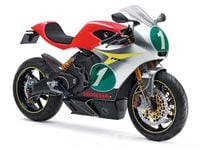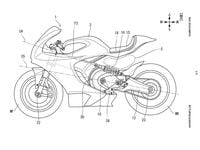Concept bikes usually fall into one of two camps. On one side there are the near-production machines that give a preview of something that will appear in showrooms a few months later, and on the other are the flights of fantasy that draw crowds to show stands for a few days, never to be seen again after their brief moment of glory.
Honda’s RC-E, which debuted at the Tokyo Motor Show way back in 2011, had all the hallmarks of being firmly in the latter group. A dozen years ago there were few serious indications that Honda had imminent plans for an electric sportbike and the RC-E—a battery-powered race-rep that took its inspiration from the company’s 1960s GP bikes—appeared to be little more than an intriguing “what if…?”
But now, nearly 12 years after the RC-E was first seen, the very same bike has become the focus of a new patent application from Honda, showing very clearly that elements of the RC-E, if not the whole bike, are still being worked on within the company’s R&D department.
The patent images are unmistakably the RC-E. The fairing shape shown in the drawings, the frame layout, the suspension, the vast electric motor in the middle, they’re all identical to the 2011 show bike. In itself, that’s not terribly unusual as Honda often patents ideas using the outlines of old bikes where the shapes themselves aren’t important. However in this case, the patent is specifically about the rear suspension’s structural layout, which in itself is a key visual element of the bike.
It’s not quite identical to the RC-E show bike. The concept had a single shock, directly mounted between the top of the swingarm ahead of the rear wheel and a bracket cast into the alloy half-frame above the electric motor. Here, we see where the new patent differs: Its shock is offset, tucking in alongside the electric motor and attached to the left-hand side of the swingarm and the left-hand frame rail. It’s more space-efficient than the original design and requires a more compact, narrower motor than the original.
However, it also shows that a large amount of the RC-E’s thinking is still current. The frame, for example, uses the electric motor’s case as a structural element between the front rails and the swingarm, which pivots concentrically with the motor’s axle. The idea is, of course, to create the straightest line possible between the steering head and the rear wheel, and the profile images make it quite clear that this layout achieves that.
The really big difference between this patent and the 2011 show bike is the context. Back in 2011 there were no serious attempts from major bike companies to make a convincing electric bike any larger than a scooter. Today the landscape is completely different. Virtually every major motorcycle company, including Honda, has laid out plans to launch large numbers of electric bikes in the very near future, and we’re simply waiting to see what they come up with. Honda could do much worse than reviving the RC-E and reinvigorating it with up-to-date motor and battery tech.
The new patent also gives us the first look under the skin of the RC-E. The motor itself has always been visible, and remains a key element of the design, but the patent reveals that there are three large battery packs, each with a unique shape, under the fairing. The first, labeled B1 in the drawings, is under the “tank” and above the frame rails. The second, B2, is larger and sits between the frame rails, hanging down into the area where we’d normally find a combustion engine. Finally there’s a third battery, B3, that’s shaped to fit into the bike’s bellypan.
The motor itself is offset to the right-hand side of the bike, leaving space for the rear shock to run alongside it on the left, and sits in a structural case bolted directly to the rear of the frame rails. Although the patent doesn’t make specific reference to it, it appears that the bike is intended to be liquid-cooled, with a conventionally positioned radiator behind the front wheel.
It’s far from certain that the patent application will be successful—it will be down to patent officials to decide whether the layout is novel enough to be protected by a patent—it’s clear that large elements of the RC-E including the half-frame and structural motor are still actively under development, and with Honda expected to launch its first big electric bike in 2024 it’s far more relevant than it was at the 2011 Tokyo Motor Show.












/cloudfront-us-east-1.images.arcpublishing.com/octane/HBYWZRHYWNAGFLQMPFRGK6TQVQ.jpg)
/cloudfront-us-east-1.images.arcpublishing.com/octane/7UNHBKGWLZGN5BAEGDFTCVNBPQ.jpg)
/cloudfront-us-east-1.images.arcpublishing.com/octane/RO36KTIVYZEATJW7CCB77EQHLQ.jpg)
/cloudfront-us-east-1.images.arcpublishing.com/octane/BUIUXSLF5RFRVJ3E26VRO5V2AY.jpg)
/cloudfront-us-east-1.images.arcpublishing.com/octane/EJJ2JBBSEZAWLFCRDALQOIBFVU.jpg)
/cloudfront-us-east-1.images.arcpublishing.com/octane/WVYKJFMINVFMFH37AE4OUEWVIM.jpg)

/cloudfront-us-east-1.images.arcpublishing.com/octane/JJ3MC6GNDFF5ZNYD3KD3E4EY7Y.jpg)
/cloudfront-us-east-1.images.arcpublishing.com/octane/XH2ETEU4NVGDFNQO2XT2QQS5LU.jpg)
/cloudfront-us-east-1.images.arcpublishing.com/octane/UFG652C27BDBFPK42TDAJ5CMX4.jpg)
/cloudfront-us-east-1.images.arcpublishing.com/octane/AUE3NFVRRZDSBIDVUGIYIDQNUI.jpg)
/cloudfront-us-east-1.images.arcpublishing.com/octane/LYR62CH2WNBMHJJVXVATZHOUE4.jpg)
/cloudfront-us-east-1.images.arcpublishing.com/octane/RBCTRGBQYBDK7A6XPG3HKPS7ZQ.jpg)
/cloudfront-us-east-1.images.arcpublishing.com/octane/MQXQRYMZVBCWJIRYP3HEN3SHVE.jpg)
/cloudfront-us-east-1.images.arcpublishing.com/octane/TSPODNNEWRDSVJGUCNQTDG4ADI.jpg)
/cloudfront-us-east-1.images.arcpublishing.com/octane/X5TB7BDV4BA2RPSY54ZGK27RP4.jpg)
/cloudfront-us-east-1.images.arcpublishing.com/octane/REUHOJXRDBGZ5IHBYZCCBCISPA.jpg)
/cloudfront-us-east-1.images.arcpublishing.com/octane/52LGJTCKBFEHDF7S7H4CVUIMGM.jpg)
/cloudfront-us-east-1.images.arcpublishing.com/octane/YMWAIPIPSJAOXOU3QMJMGH37OM.jpg)


/cloudfront-us-east-1.images.arcpublishing.com/octane/EJ6KZRGAYBCVXNL2PJXL37UVWQ.jpg)
/cloudfront-us-east-1.images.arcpublishing.com/octane/AAN4TI76M5H5JMUVEIGASWXBDU.jpg)
/cloudfront-us-east-1.images.arcpublishing.com/octane/P3RXD2UCPFF37CMB7CHPVKXORY.jpg)
/cloudfront-us-east-1.images.arcpublishing.com/octane/VZEG2EJI2RDFZNHLRZMU56MD3Q.jpg)
/cloudfront-us-east-1.images.arcpublishing.com/octane/GVJQO5FFOFBWNGODOBRB4FBAW4.jpg)